New pasture guide launched to support farmers in a changing climate
A new publication has been launched that offers a comprehensive and up-to-date resource on commercially available grazing pasture species in New Zealand.
Pasture based farming is most profitable when the pastures are managed to provide the highest quality feed at all periods during the season, maximising the amount of pasture grown and eaten.
The major problem we farmers face as pasture managers is that often the needs of the livestock are competing with the needs of the pasture. Pasture management should win, but to make profitable decisions we must understand the compromises constantly being made.
For example, if our cows are fed all they can eat, to graze in a relaxed way and without walking far, they could easily produce 600kgMS/cow. But if we try that across a whole farm, pasture quality will become poor and overall pasture quantity harvested very low – which is simply not a profitable system.
On the other hand, if we have many cows (high stocking rate) the constant high demand will result in low after-grazing residuals all the time. We will have high quality pasture but cows using too much of the energy they have eaten to maintain themselves, resulting in low production and a low profit system.
Understanding ryegrass pastures is a key to making profitable daily and seasonal decisions, and this can be broken down into five key categories:
1. Grazing residual management is the most important key to profitable pasture production systems.
Correct residuals ensure adequate leaf area to help maximise regrowth while still limiting the formation of clumps in the pastures, which the cows will not graze willingly.
The residual left after each grazing should be 1500-1650kgDM/ha – with exceptions in late autumn and winter. If pastures are grazed below the correct level the plants take much longer to recover, with the effect that overall pasture growth is less.
If long residuals are left, the feed that was high quality will likely decline in quality and much of it will die off. This feed, if harvested at a following grazing, is lower quality and will produce less milk or liveweight gain and will also reduce appetite which further drives down production.
An important thing is for the residuals on a farm to be consistent even if a little higher than ideal.
From time to time mistakes will be made, leaving residuals longer than ideal. Strategies will be discussed later in the article to deal with this situation, e.g. mowing.
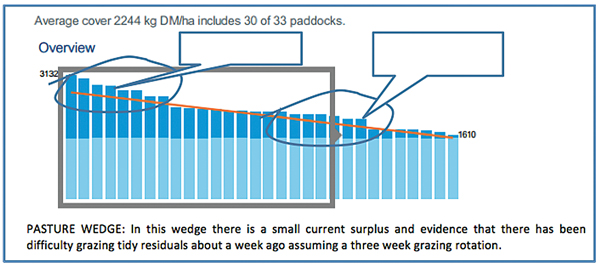
2. Know the correct range for grazing intervals for a farm and farm system and stick to them.
Ryegrass is a 3-leaf plant. When it has grown three leaves after grazing the oldest leaf will begin to die and by the time the fourth leaf is fully grown the first leaf has died.
Grazing to achieve highest yield of quality feed will occur when pastures are approaching the third leaf fully grown stage.
In mid spring a new ryegrass leaf will be formed each 5-8 days and leaves will begin to die off at 18-24 days. Therefore grazing rotations should as much as possible match the rate at which fourth leaves are about to appear.
In early autumn a new leaf will be formed in 10-12 days and leaves begin to die off at 30-35 days, therefore rotation lengths need to be lengthened (to 30-45 days).
Maximum grass growth rates are achieved when pasture cover is 2200-2800kg/DM/ha.
The ideal pasture cover 'window' in which cows should be pre-grazing is 2600-3000kgDM/ha depending on variety of ryegrass.
Where cocksfoot and fescue dominant paddocks are involved, they should be grazed at 2400-2600kgDM/ha when pasture quality is at its highest and to prevent the formation of high crown clumps.
Recording and calculating grazing intervals and rotation lengths is a key to understanding the various pastures and areas on a farm.
Accurately recording this information, using it to make decisions and storing it for later consideration, are important skills for pasture mangers. There are many good examples of this data sheet process in reports from various monitor and demonstration farms like the Lincoln University Dairy farm. Available at www.siddc.org.nz.
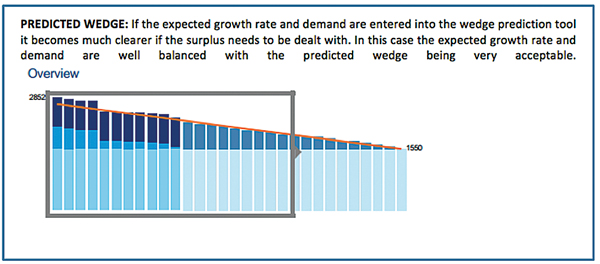 3. Estimate the pasture cover and growth rate regularly.
3. Estimate the pasture cover and growth rate regularly.
Take a weekly farm walk (or with a tow-behind or feed reader) to get an estimate of the pre and post grazing dry matter levels and average pasture cover. This information can tell the decisionmaker a lot about what is happening.
Tools on the web can take live data from smartphones that help record what the situation is and allow smart predictions about what it will be like in the next week or two, e.g. a pasture wedge; see examples from the LIC Minda Land and Feed software.
The wedge is simply the paddocks assembled in the order from the highest to the lowest, to help the pasture manager use the highest paddocks first. The picture that results when the demand line is drawn correctly across the wedge immediately shows surplus or deficit at present or likely in a week or fortnight.
The software will also keep a record of annual pasture growth for each paddock, providing excellent data for decisions about pasture renewal.
4. Understand the supply demand natural surplus and deficit and what profitable strategies are available.
Feed demand must be reduced as autumn proceeds – the urgency of this depends on potential winter growth rate and farm policy on the use of supplements (see graph p15).
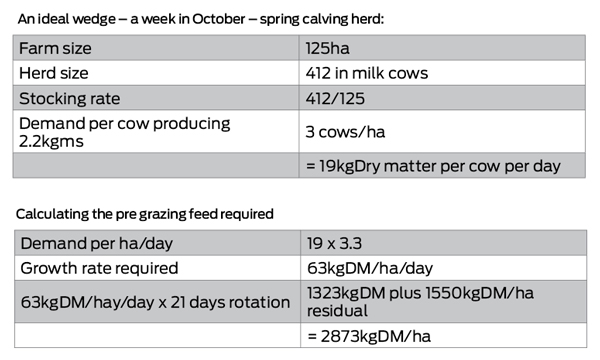 Strategies used to achieve maximum days in milk:
Strategies used to achieve maximum days in milk:
Culling cows that will not be part of next year's herd to ensure there is enough feed to carry the remainder through to the end of the lactation period
Changing milking interval to 3 times in two days or once a day reduces demand from the cows enabling available feed to be used on more days.
5. Know how to manage the round length and residuals.
In the first part of spring, growth rates are low and feed demand is increasing much more quickly than the supply. Pasture cover in this case is managed by strictly controlling the length of the first grazing round.
The first round is set so that it finishes a little earlier than the date that pastures' supply and demand will be equal.
Rotation lengths following this should be set to match the expected time that 2.5 leaves will take to be generated.
Through the grass flowering stages of the pasture – late October until early January – difficult-to-eat stem material often builds in the base of pasture. This is hard for cows to eat because it is tough and is much less digestible and has more endophyte in it than higher up the grass plants. Many pasture managers use a mower to help re-adjust the residual back to 1600kgDM/ha during this period.
If the stocking rate, equipment and paddock surface allow it, many farmers will mow each pasture at least once in this period. Re-setting the residual improves the overall quality and palatability of the pasture. Our FarmWise colleague Brent Boyce has a saying – "thump the clumps" – to help farmers think about what this process is meant to achieve.
If the mowing is well planned it can be done just before the cows go into the pasture. Mowing in front, if done well, re-sets the residual and helps maintain the appetite of the herd to make good use of the quality pasture that follows the mowing.
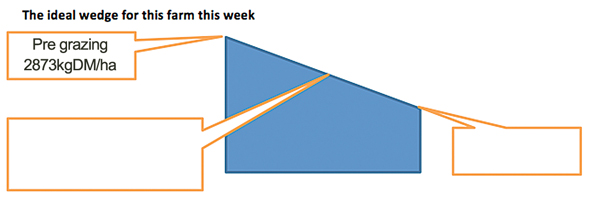 Any mowing must re-set the residual to below 1650kgDM to be of value and be likely to be a profitable activity. Some farmers talk about topping and pretty much do just that with slashers and flails with blunt blades to 'chew' off the top of the pasture, but not low enough to reset the residual. Topping like this – not cutting grass off cleanly – damages the plants and will give relatively slow re-growth.
Any mowing must re-set the residual to below 1650kgDM to be of value and be likely to be a profitable activity. Some farmers talk about topping and pretty much do just that with slashers and flails with blunt blades to 'chew' off the top of the pasture, but not low enough to reset the residual. Topping like this – not cutting grass off cleanly – damages the plants and will give relatively slow re-growth.
The high residual leaves a lot of low quality feed on the paddock. It has little chance of being a profitable thing to do: a waste of time, diesel and machinery wear and tear.
Use of other cattle to reset the residual
Non-milking cattle can be useful to re-set pasture residuals. A mob of carryover cows is great for this if there are enough of them and they do not interfere with having adequate feed for the herd. Replacement heifers can be of use but great care must be taken to avoid not achieving targeted liveweight gains in these fast growing young cattle. Having them eat pasture that has been allowed to regrow to, say, 2500kg but has had a high previous residual that needs to be re-set can be an OK strategy.
Doing the residual re-set over two or three herd grazings
This can be OK but must be done with great care; avoid being too impatient and reducing the appetite of the herd more than is natural for the time of year.
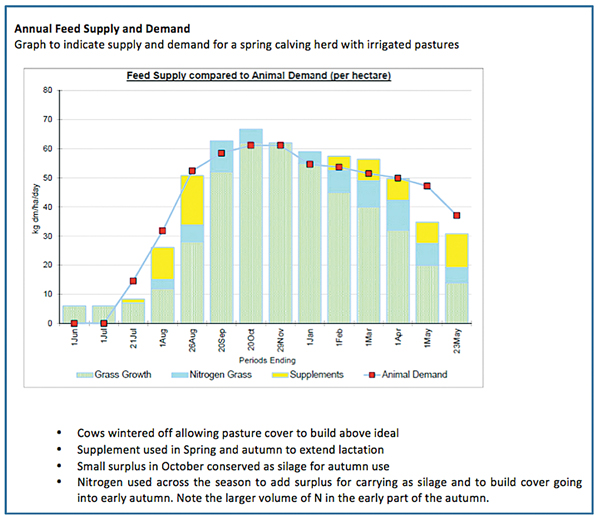 Rotation lengths mid-summer and beyond
Rotation lengths mid-summer and beyond
As the season progresses toward summer, if the farm is likely to be dry and have a slower growth rate, then the rotation length must be slowed down as the dry sets in (there is no point until it begins to get dry). Round length will be based on previous knowledge about growth rates in summer and attitudes to the current season.
This slowing down and avoiding grazing too often has been well proven in research over many years to look after the pasture plants in a better way and enable them to grow much more strongly in the autumn and winter and even next spring.
Round lengths that use 1/26th to 1/30th of the farm are typically correct. If the round is too slow the pre-grazing levels get too high, making it difficult to achieve correct residual and adequate cow intake. Quite a balancing act!
In the autumn
The grazing interval must be extended so that even at the end of May there is full feed available. To achieve this, the previous grazing may have had to be 45 days earlier or longer if further south. Pasture growth rate and daily demand needs to be part of this budgeting/planning process.
The role of supplements in pasture management
Cows enjoy good quality supplements and will almost always replace some of the pasture they would have eaten with the supplement.
When there is a definite shortage of pasture, supplements can fill the gap and are often profitable.
The most likely profitable feeding will be to bridge across a dry summer avoiding over grazing pasture, in early spring to avoid under feeding and in autumn extending lactation.
Pasture is the cheapest feed on our farms and must be the focus if full advantage of it is to occur.
Too many dairy farm managers and owners become focused on per cow production rather than focusing on profit from the whole farm system and especially maximising pasture yield and quality.
It is essential that the five basics are achieved.
The National Wild Goat Hunting Competition has removed 33,418 wild goats over the past three years.
New Zealand needs a new healthcare model to address rising rates of obesity in rural communities, with the current system leaving many patients unable to access effective treatment or long-term support, warn GPs.
Southland farmers are being urged to put safety first, following a spike in tip offs about risky handling of wind-damaged trees
Third-generation Ashburton dairy farmers TJ and Mark Stewart are no strangers to adapting and evolving.
When American retail giant Cosco came to audit Open Country Dairy’s new butter plant at the Waharoa site and give the green light to supply their American stores, they allowed themselves a week for the exercise.
Fonterra chair Peter McBride says the divestment of Mainland Group is their last significant asset sale and signals the end of structural changes.